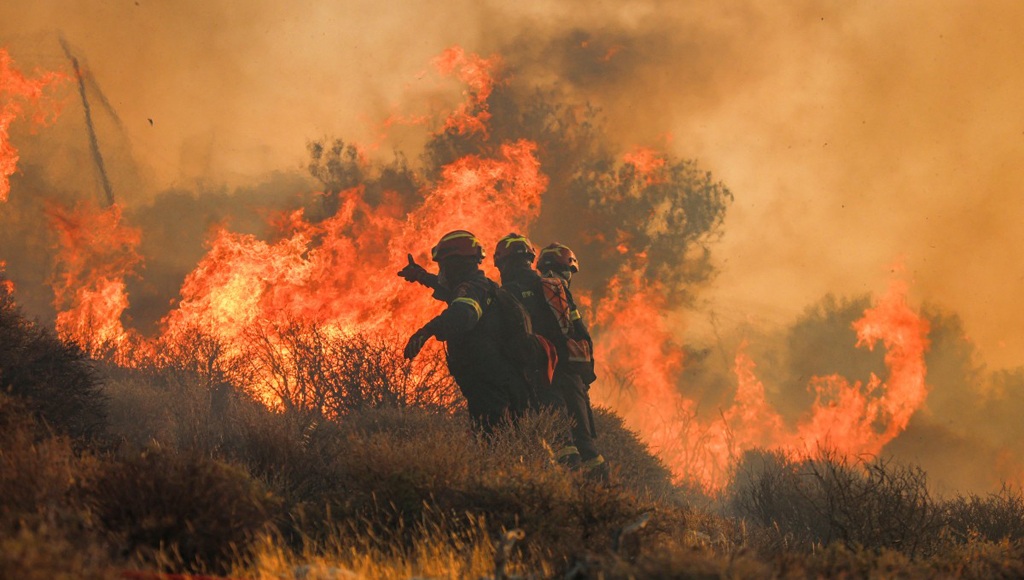Countries along the Mediterranean are grappling with a fierce and rapidly expanding wave of wildfires and record-breaking temperatures as a summer heatwave sweeps through Southern Europe and parts of the Middle East.
Online reports as at Monday, July 7, 2025, say that with each passing day, the scorching heat intensifies, forcing communities to evacuate.
This has prompted emergency services to be placed on high alert, and forecasters to warn that this may be the first of several such periods this year.
The crisis began to unfold on Sunday, with wildfires erupting in Greece, Turkiye, France, and Syria.
Meanwhile, major heat alerts were issued from Spain to Italy, where officials urged residents to look out for vulnerable individuals, especially the elderly and young, and to restrict non-essential travel.
In tourist hotspots, ambulances and emergency crews were stationed at strategic locations, ready to respond to heat-related illnesses.
Meteorologists warn this phenomenon is no rare occurrence.
While heatwaves have always been part of Mediterranean summers, they are now growing more frequent and ferocious due to climate change
Wildfires Across the Region
Turkiye
In western Turkiye’s Izmir province, fierce wildfires ignited on Sunday, driven by strong winds that rapidly spread the flames.
Firefighters supported by aerial units battled the blaze as authorities ordered the evacuation of Seferihisar’s five neighborhoods.
Over the preceding week, crews tackled more than 600 fires nationwide, leading to ten arrests connected to suspected fire-raising
Tragically, at least three people died in Izmir, and a new fire broke out in Dortyol, Hatay province, sending nearly 2,000 residents fleeing
Greece
Over 160 firefighters—with 46 fire trucks and five aircraft—were deployed to southern Evia after a major wildfire broke out late Friday. Multiple villages were evacuated as searing heat wave–enhanced wildfires simultaneously ignited near Athens
On Crete, around 230 firefighters fought a blaze fueled by 50 mph winds and temperatures well above seasonal norms. Over 1,500 residents and tourists were evacuated, alongside 5,000 others who fled independently
France
The southwestern Corbieres region in Aude saw temperatures exceed 40 °C, igniting wildfires that forced campers and visitors to an abbey to evacuate
With 84 out of 101 departments under “orange” heat alert, authorities issued broad warnings for high-risk areas
Heatwave’s Far-reaching Toll
Spain reached 44 °C in Extremadura and Andalusia; in Catalonia, two farmers died while fleeing flames
Italy placed 21 cities, including Rome, Milan, and Naples, on red alert.
Emergency rooms recorded a 10% surge in heatstroke cases
Portugal faced red warnings in Lisbon and across two-thirds of the country. Sicily’s firefighters battled 15 fires in one day
These are not isolated events. June’s heat dome pushed many regions 5–10 °C above normal, turning coastal seas into virtual ovens and triggering drought conditions that ignited flames .
Health officials reported hospital admissions rising across the board, particularly for dehydration, heat exhaustion, and heatstroke among elderly, chronically ill, and homeless individuals .
Why This Is a Climate Flashpoint
Scientists emphasize that these intense heatwaves are part of a worrying global pattern driven by human-induced climate change
Europe is heating at twice the global rate, with unusual early peaks already normalizing extreme conditions
“Extreme heat is no longer a rare event—it’s becoming the new normal,” UN Secretary-General António Guterres warned during a scorching visit to Seville
Predictive models now suggest that nearly half of Europeans may be exposed to severe heat stress by 2050
Experts argue that better urban planning, early-warning systems, and resilience infrastructure are urgently needed to prevent mass casualties and societal disruption .
What Authorities and Aid Agencies Are Doing
The IFRC and Red Crescent have mobilized across the region, supporting firefighting crews and distributing essential water and food supplies to evacuated populations.
They stress the risk is far from over: with more heatwaves expected through September, preparedness must shift from reactive responses to proactive strategies
Authorities have enforced work bans during peak hours in places like Italy’s Lazio, Tuscany and Ulmbra.
They have also enforced work bans on Calabria, Puglia, and northern Portugal to protect outdoor workers from severe exposure.
France implemented road restrictions near Paris to mitigate ozone and air pollution, and provided free public pool access in Marseille to help citizens beat the heat.
What Lies Ahead
Heat maps forecast continued extreme temperatures across much of Southern Europe and the Mediterranean.
A sharper focus is needed on climate resilience, sustainable urban design, and disaster management infrastructure to protect vulnerable communities and critical ecosystems.
If authorities can learn from this summer’s early heatwave and reinforce resilience, they might avoid far more devastating consequences next year, or the year after.



